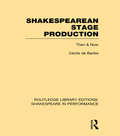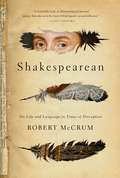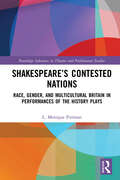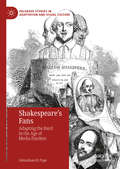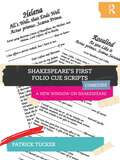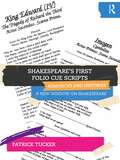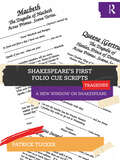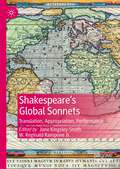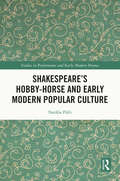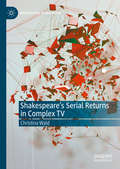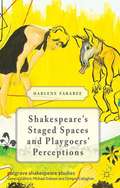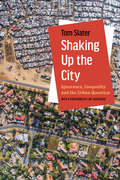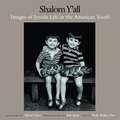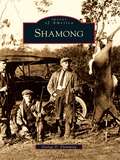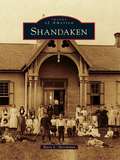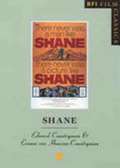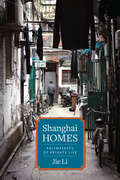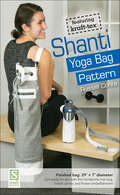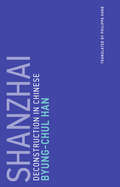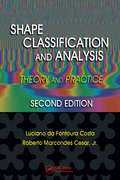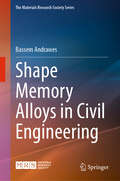- Table View
- List View
Shakespearean Neuroplay
by Amy Cook"Shakespearean Neuroplay" provides a methodology for applying cognitive science to the study of drama and performance. With Shakespeare's "Hamlet" as a test subject and the cognitive linguistic theory of conceptual blending as a tool, Cook unravels the "mirror held up to nature" at the center of Shakespeare's play. Hamlet's mirror becomes a conceptual structure that invisibly scaffolds our understanding of the play. A lucid explanation of both contemporary science and "Hamlet," "Shakespearean Neuroplay" unveils Shakespeare's textual theatrics and sheds light on blind spots in theatre and performance theory.
Shakespearean Sensations
by Katharine A. Craik Tanya PollardThis strong and timely collection provides fresh insights into how Shakespeare's plays and poems were understood to affect bodies, minds and emotions. Contemporary criticism has had surprisingly little to say about the early modern period's investment in imagining literature's impact on feeling. Shakespearean Sensations brings together scholarship from a range of well-known and new voices to address this fundamental gap. The book includes a comprehensive introduction by Katharine A. Craik and Tanya Pollard and comprises three sections focusing on sensations aroused in the plays; sensations evoked in the playhouse; and sensations found in the imaginative space of the poems. With dedicated essays on Hamlet, Macbeth, Othello and Twelfth Night, the collection explores how seriously early modern writers took their relationship with their audiences and reveals new connections between early modern literary texts and the emotional and physiological experiences of theatregoers.
Shakespearean Stage Production: Then and Now (Routledge Library Editions: Shakespeare in Performance #3)
by Cécile De BankeAn absorbing and original addition to Shakespeareana, this handbook of production is for all lovers of Shakespeare whether producer, player, scholar or spectator. In four sections, Staging, Actors and Acting, Costume, Music and Dance, it traces Shakespearean production from Elizabethan times to the 1950s when the book was originally published. This book suggests that Shakespeare should be performed today on the type of stage for which his plays were written. It analyses the development of the Elizabethan stage, from crude inn-yard performances to the building and use of the famous Globe. Since the Globe saw the enactment of some of the Bard’s greatest dramas, its construction, properties, stage devices, and sound effects are reviewed in detail with suggestions on how a producer can create the same effects on a modern or reconstructed Elizabethan stage. Shakespeare’s plays were written to fit particular groups of actors. The book gives descriptions of the men who formed the acting companies of Elizabethan London and of the actors of Shakespeare’s own company, giving insights into the training and acting that Shakespeare advocated. With full descriptions and pages of reproductions, the costume section shows the types of dress necessary for each play, along with accessories and trimmings. A table of Elizabethan fabrics and colours is included. The final section explores the little-known and interesting story of the integral part of music and dance in Shakespeare’s works. Scene by scene the section discusses appropriate music or song for each play and supplies substitute ideas for Elizabethan instruments. Various dances are described – among them the pavan, gailliard, canary and courante. This book is an invaluable wealth of research, with extensive bibliographies and extra information.
Shakespearean: On Life and Language in Times of Disruption
by Robert McCrum"A remarkable book that takes us to the heart of Shakespeare's art and influence."—James ShapiroWhen Robert McCrum began his recovery from a life-changing stroke, he discovered that the only words that made sense to him were snatches of Shakespeare. Unable to travel or move as he used to, the First Folio became his "book of life"—an endless source of inspiration through which he could embark on "journeys of the mind" and see a reflection of our own disrupted times. An acclaimed writer and journalist, McCrum has spent the last twenty-five years immersed in Shakespeare's work, on stage and on the page. During this prolonged exploration, Shakespeare&’s poetry and plays, so vivid and contemporary, have become his guide and consolation. In Shakespearean he asks: why is it that we always return to Shakespeare, particularly in times of acute crisis and dislocation? What is the key to his hold on our imagination? And why do the collected works of an Elizabethan writer continue to speak to us as if they were written yesterday? Shakespearean is a rich, brilliant and superbly drawn portrait of an extraordinary artist, one of the greatest writers who ever lived. Through an enthralling narrative, ranging widely in time and space, McCrum seeks to understand Shakespeare within his historical context while also exploring the secrets of literary inspiration, and examining the nature of creativity itself. Witty and insightful, he makes a passionate and deeply personal case that Shakespeare&’s words and ideas are not just enduring in their relevance – they are nothing less than the eternal key to our shared humanity.
Shakespeare’s Contested Nations: Race, Gender, and Multicultural Britain in Performances of the History Plays (Routledge Advances in Theatre & Performance Studies)
by L. Monique PittmanShakespeare’s Contested Nations argues that performances of Shakespearean history at British institutional venues between 2000 and 2016 manifest a post-imperial nostalgia that fails to tell the nation’s story in ways that account for the agential impact of women and people of color, thus foreclosing promising opportunities to re-examine the nation’s multicultural past, present, and future in more intentional, self-critical, and truly progressive ways. A cluster of interconnected stage and televisual performances and adaptations of the history play canon illustrate the function that Shakespeare’s narratives of incipient "British" identities fulfill for the postcolonial United Kingdom. The book analyzes treatments of the plays in a range of styles—staged performances directed by Michael Boyd with the Royal Shakespeare Company (2000–2001) and Nicholas Hytner at the National Theatre (2003, 2005), the BBC’s Hollow Crown series (2012, 2016), the RSC and BBC adaptations of Wolf Hall and Bring Up the Bodies (2013, 2015), and a contemporary reinterpretation of the canon, Mike Bartlett’s King Charles III (2014, 2017). This book will be of great interest to scholars and students of Shakespeare, theatre, and politics.
Shakespeare’s Fans: Adapting the Bard in the Age of Media Fandom (Palgrave Studies in Adaptation and Visual Culture)
by Johnathan H. PopeThis book examines Shakespearean adaptations through the critical lens of fan studies and asks what it means to be a fan of Shakespeare in the context of contemporary media fandom. Although Shakespeare studies and fan studies have remained largely separate from one another for the past thirty years, this book establishes a sustained dialogue between the two fields. In the process, it reveals and seeks to overcome the problematic assumptions about the history of fan cultures, Shakespeare’s place in that history, and how fan works are defined. While fandom is normally perceived as a recent phenomenon focused primarily on science fiction and fantasy, this book traces fans’ practices back to the eighteenth century, particularly David Garrick’s Shakespeare Jubilee in 1769. Shakespeare’s Fans connects historical and scholarly debates over who owns Shakespeare and what constitutes an appropriate adaptation of his work to online fan fiction and commercially available fan works.
Shakespeare’s First Folio Cue Scripts - Comedies: A New Window on Shakespeare
by Patrick TuckerOpening up a new window to see Shakespeare’s words in a different light and gathering his intentions in a simple, clear way, this book presents the Cue Scripts from the Comedies in Shakespeare’s First Folio.The book invites readers to approach Shakespeare’s texts the way his actors would have – not studying the complete text and drawing conclusions from it, but working from a Cue Script, where all the lines for a particular character are written, with just a two- or three-word cue as to when they should speak. As an actor himself, Shakespeare knew that his actors would have little time to do more than learn their lines for the next imminent performance – for this reason, he placed in the first lines of every Cue Script a range of crucial information on the character’s motives and intentions. Studying the cues and following the playwright’s clues opens up a whole new understanding of the roles, and provides a way of approaching a play that is authentic, quick, and creates an impactful performance. Examples of Cue Script scenes along with a summary of the various clues that were written to help the original actors are included in the book.A practical and unique resource for students, teachers, performers, and directors alike, Shakespeare’s First Folio Cue Scripts – Comedies helps demystify Shakespeare’s texts, provides new approaches to scene studies, and sheds new light on Shakespeare’s most popular works.To access the additional downloadable Cue Scripts and other materials, visit www.resourcecentre.routledge.com/books/9781032698823.
Shakespeare’s First Folio Cue Scripts – Romances and Histories: A New Window on Shakespeare
by Patrick TuckerOpening up a new window to see Shakespeare’s words in a different light and gathering his intentions in a simple, clear way, this book presents the Cue Scripts from the Romances and Histories in Shakespeare’s First Folio.The book invites readers to approach Shakespeare’s texts the way his actors would have – not studying the complete text and drawing conclusions from it, but working from a Cue Script, where all the lines for a particular character are written, with just a two- or three-word cue as to when they should speak. As an actor himself, Shakespeare knew that his actors would have little time to do more than learn their lines for the next imminent performance – for this reason, he placed in the first lines of every Cue Script a range of crucial information on the character’s motives and intentions. Studying the cues and following the playwright’s clues opens up a whole new understanding of the roles, and provides a way of approaching a play that is authentic, quick, and creates an impactful performance. Examples of Cue Script scenes along with a summary of the various clues that were written to help the original actors are included in the book.A practical and unique resource for students, teachers, performers, and directors alike, Shakespeare’s First Folio Cue Scripts – Romances and Histories helps demystify Shakespeare’s texts, provides new approaches to scene studies, and sheds new light on Shakespeare’s most popular works.To access the additional downloadable Cue Scripts and other materials, visit www. resourcecentre.routledge.com/books/9781032698847.
Shakespeare’s First Folio Cue Scripts – Tragedies: A New Window on Shakespeare
by Patrick TuckerOpening up a new window to see Shakespeare’s words in a different light and gathering his intentions in a simple, clear way, this book presents the Cue Scripts from the Tragedies in Shakespeare’s First Folio.The book invites readers to approach Shakespeare’s texts the way his actors would have – not studying the complete text and drawing conclusions from it, but working from a Cue Script, where all the lines for a particular character are written, with just a two- or three-word cue as to when they should speak. As an actor himself, Shakespeare knew that his actors would have little time to do more than learn their lines for the next imminent performance – for this reason, he placed in the first lines of every Cue Script a range of crucial information on the character’s motives and intentions. Studying the cues and following the playwright’s clues opens up a whole new understanding of the roles, and provides a way of approaching a play that is authentic, quick, and creates an impactful performance. Examples of Cue Script scenes along with a summary of the various clues that were written to help the original actors are included in the book.A practical and unique resource for students, teachers, performers, and directors alike, Shakespeare’s First Folio Cue Scripts – Tragedies helps demystify Shakespeare’s texts, provides new approaches to scene studies, and sheds new light on Shakespeare’s most popular works.To access the additional downloadable Cue Scripts and other materials, visit www.resourcecentre.routledge.com/books/9781032698854.
Shakespeare’s Global Sonnets: Translation, Appropriation, Performance (Global Shakespeares)
by Jane Kingsley-Smith W. Reginald Rampone Jr.This edited collection brings together scholars from across the world, including France, Italy, Germany, Hungary, Japan, the USA and India, to offer a truly international perspective on the global reception of Shakespeare’s Sonnets from the 18th century to the present. Global Shakespeare has never been so local and familiar as it is today. The translation, appropriation and teaching of Shakespeare’s plays across the world have been the subject of much important recent work in Shakespeare studies, as have the ethics of Shakespeare’s globalization. Within this discussion, however, the Sonnets are often overlooked. This book offers a new global history of the Sonnets, including the first substantial study of their translation and of their performance in theatre, music and film. It will appeal to anyone interested in the reception of the Sonnets, and of Shakespeare across the world.
Shakespeare’s Hobby-Horse and Early Modern Popular Culture (Studies in Performance and Early Modern Drama)
by Natália PikliThis book explores the ways in which the early modern hobby-horse featured in different productions of popular culture between the 1580s and 1630s. Natália Pikli approaches this study with a thorough and interdisciplinary examination of hobby-horse references, with commentary on the polysemous uses of the word, offers an informative background to reconsider well-known texts by Shakespeare and others, and provides an overview on the workings of cultural memory regarding popular culture in early modern England. The book will appeal to those with interest in early modern drama and theatre, dramaturgy, popular culture, cultural memory, and iconography.
Shakespeare’s Serial Returns in Complex TV (Reproducing Shakespeare)
by Christina WaldThis book examines how Shakespeare’s plays resurface in current complex TV series. Its four case studies bring together The Tempest and the science fiction-Western Westworld, King Lear and the satirical dynastic drama of Succession, Hamlet and the legal thriller Black Earth Rising, as well as Coriolanus and the political thriller Homeland. The comparative readings ask what new insights the twenty-first-century remediations may grant us into Shakespeare’s texts and, vice versa, how Shakespearean returns help us understand topical concerns negotiated in the series, such as artificial intelligence, the safeguarding of democracy, terrorism, and postcolonial justice. This study also proposes that the dramaturgical seriality typical of complex TV allows insights into the seriality Shakespeare employed in structuring his plays. Discussing a broad spectrum of adaptational constellations and establishing key characteristics of the new adaptational aggregate of serial Shakespeare, it seeks to initiate a dialogue between Shakespeare studies, adaptation studies, and TV studies.
Shakespeare’s Staged Spaces and Playgoers’ Perceptions
by Darlene FarabeeThis engaging study offers fresh readings of canonical Shakespeare plays, illuminating ways stagecraft and language of movement create meaning for playgoers. The discussions engage materials from the period, present revelatory readings of Shakespeare's language, and demonstrate how these continually popular texts engage all of us in making meaning.
Shaking Up the City: Ignorance, Inequality, and the Urban Question
by Tom SlaterShaking Up the City critically examines many of the concepts and categories within mainstream urban studies that serve dubious policy agendas. Through a combination of theory and empirical evidence, Tom Slater "shakes up" mainstream urban studies in a concise and pointed fashion by turning on its head much of the prevailing wisdom in the field. To this end, he explores the themes of data-driven innovation, urban resilience, gentrification, displacement and rent control, neighborhood effects, territorial stigmatization, and ethnoracial segregation. With important contributions to ongoing debates in sociology, geography, urban planning, and public policy, this book engages closely with struggles for land rights and housing justice to offer numerous insights for scholarship and political action to guard against the spread of an urbanism rooted in vested interest.
Shalom Y'All: Images of Jewish Life in the American South
by Alfred Uhry Bill Aron Vicki Reikes FoxThe kitchen of Henrietta Levine in Pine Bluff, Arkansas, where chopped liver is sautTing. Ben and Betty Lee Lamensdorf's farmland in Cary, Mississippi, where cotton, wheat, and pecans are harvested. The New Americans Social Club, a group of Holocaust survivors that meet regularly in New Orleans. The historic and flourishing Temple Emanu-El in Birmingham, Alabama. From Levy, Arkansas, to Kaplan, Louisiana, Southern Jewish culture is alive and well below the Mason-Dixon line. In Shalom Y'all, award-winning photographer Bill Aron provides a vibrant portrait of contemporary Jewish life, dutifully recording the heroic, funny, and sometimes tragic experiences of a people who have long settled in the Bible Belt. With a moving foreword by Alfred Uhry, author of Driving Miss Daisy, this book covers all aspects of the Jewish experience, from food (chopped liver, of course, but also bagels and grits) to occupations to religious practices to friendships. Together, the text and photographs tell a story of a culture that has managed, with a mixture of good humor, perseverance, and faith, to make a home.
Shamong (Images of America)
by George D. FlemmingShamong Township, incorporated in 1852, was originally a part of Evesham Township. It is one of many communities that make up the Pinelands National Reserve. Shamong is a Native American word meaning "place of the horn" or "place of many deer." From 1758 until 1802, 3,284 acres of the township were home to the first and only Native American reservation in New Jersey. Prominent citizens of old Shamong included John B. Gardner, former mayor of Atlantic City, Civil War veteran, and United States congressman. James Still, the famed "black doctor of the Pines," was born in Shamong in 1812, and his younger brother, William Still, is celebrated as the father of the Underground Railroad. The photographs in Shamong provide a visual reminder of the past and celebrate the history of this community, which remains a vibrant rural and residential area.
Shandaken (Images of America)
by Mary L. HerrmannShandaken is known as the "Heart of the Catskill Mountains." In the town's early years, leather tanning, barrel hoop shaving, and quarrying were mainstays of employment and were relied on by local residents. With time, each of these industries became obsolete due to modern advances and developments. Shandaken was revitalized with the arrival of the railroad, which enabled New York City residents to escape the summer heat and travel to the many hotels that sprang up in town. Tourism increased with the formation of the Forrest Preserve, the Catskill Park, and the New York City watershed. Later winter tourism boomed with the popularity of skiing. Although Shandaken has endured many changes, it has retained its charm and historic character.
Shane
by Edward Countryman Evonne Von Heussen-CountrymanDirected by George Stevens, then one of Hollywood's most successful filmmakers, "Shane" (1952) is one of the most revered and imitated of all westerns. Starring Alan Ladd as a mysterious drifter who protects a fledgling community from a predatory gang, "Shane" is one of the definitive reimaginings of America's frontier mythology. This is, remarkably, the first substantial study of "Shane." In it, Edward Countryman and Evonne von Heussen-Countryman show, with reference to a wide range of historical and archival sources, how subtly the film treats some fundamental themes: family, the history of settlement and community in America, violence, and the culture of the gun.
Shanghai Homes: Palimpsests of Private Life
by Jie LiExploring three dimensions of private life territories, artifacts, and gossip Li re-creates the sounds, smells, look, and feel of home over a tumultuous century
Shanghai Homes: Palimpsests of Private Life (Global Chinese Culture)
by Jie LiIn the dazzling global metropolis of Shanghai, what has it meant to call this city home? In this account—part microhistory, part memoir—Jie Li salvages intimate recollections by successive generations of inhabitants of two vibrant, culturally mixed Shanghai alleyways from the Republican, Maoist, and post-Mao eras. Exploring three dimensions of private life—territories, artifacts, and gossip—Li re-creates the sounds, smells, look, and feel of home over a tumultuous century. First built by British and Japanese companies in 1915 and 1927, the two homes at the center of this narrative were located in an industrial part of the former "International Settlement." Before their recent demolition, they were nestled in Shanghai's labyrinthine alleyways, which housed more than half of the city's population from the Sino-Japanese War to the Cultural Revolution. Through interviews with her own family members as well as their neighbors, classmates, and co-workers, Li weaves a complex social tapestry reflecting the lived experiences of ordinary people struggling to absorb and adapt to major historical change. These voices include workers, intellectuals, Communists, Nationalists, foreigners, compradors, wives, concubines, and children who all fought for a foothold and haven in this city, witnessing spectacles so full of farce and pathos they could only be whispered as secret histories.
Shanti Yoga Bag Pattern: Featuring kraft-tex
by Russell ConteCombine durable and stylish kraft-tex with hefty denim to create a yoga bag meant to last! The handy shoulder strap and exterior zippered pocket are pretty and practical, while the water bottle holder with an adjustable strap adds even more functionality. Then give some flair to the whole ensemble with a magnolia flower accent made entirely of kraft-tex. Meanwhile, learn new skills inspired by shoe-making, including a goiser stitch around the zippered pocket and brogueing details on the water bottle holder that show off the back of the denim through the kraft-tex. Perfect gift for yourself or the yogi in your life Work with pristine, understated kraft-tex, or embellish your bag with paints and inks Add interest to your project as you learn new techniques for working with thicker materials
Shantytown, USA: Forgotten Landscapes of the Working Poor
by Lisa GoffShantytowns once occupied a central place in America's urban landscape. Lisa Goff shows how these resourceful dwellings were not merely the byproducts of hardship but potent assertions of self-reliance. Their legacy is felt in sites of political activism, from campus shanties protesting apartheid to the tent cities of Occupy Wall Street.
Shanzhai: Deconstruction in Chinese (Untimely Meditations #8)
by Byung-Chul HanTracing the thread of “decreation” in Chinese thought, from constantly changing classical masterpieces to fake cell phones that are better than the original.Shanzhai is a Chinese neologism that means “fake,” originally coined to describe knock-off cell phones marketed under such names as Nokir and Samsing. These cell phones were not crude forgeries but multifunctional, stylish, and as good as or better than the originals. Shanzhai has since spread into other parts of Chinese life, with shanzhai books, shanzhai politicians, shanzhai stars. There is a shanzhai Harry Potter: Harry Potter and the Porcelain Doll, in which Harry takes on his nemesis Yandomort. In the West, this would be seen as piracy, or even desecration, but in Chinese culture, originals are continually transformed—deconstructed. In this volume in the Untimely Meditations series, Byung-Chul Han traces the thread of deconstruction, or “decreation,” in Chinese thought, from ancient masterpieces that invite inscription and transcription to Maoism—“a kind a shanzhai Marxism,” Han writes.Han discusses the Chinese concepts of quan, or law, which literally means the weight that slides back and forth on a scale, radically different from Western notions of absoluteness; zhen ji, or original, determined not by an act of creation but by unending process; xian zhan, or seals of leisure, affixed by collectors and part of the picture's composition; fuzhi, or copy, a replica of equal value to the original; and shanzhai. The Far East, Han writes, is not familiar with such “pre-deconstructive” factors as original or identity. Far Eastern thought begins with deconstruction.
Shape Classification and Analysis: Theory and Practice, Second Edition (Image Processing Series)
by Luciano da Costa Roberto Marcond Cesar, Jr.Because the properties of objects are largely determined by their geometric features, shape analysis and classification are essential to almost every applied scientific and technological area. A detailed understanding of the geometrical features of real-world entities (e.g., molecules, organs, materials and components) can provide important clues about their origin and function. When properly and carefully applied, shape analysis offers an exceedingly rich potential to yield useful applications in diverse areas ranging from material sciences to biology and neuroscience.Get Access to the Authors’ Own Cutting-Edge Open-Source Software Projects—and Then Actually Contribute to Them Yourself! The authors of Shape Analysis and Classification: Theory and Practice, Second Edition have improved the bestselling first edition by updating the tremendous progress in the field. This exceptionally accessible book presents the most advanced imaging techniques used for analyzing general biological shapes, such as those of cells, tissues, organs, and organisms. It implements numerous corrections and improvements—many of which were suggested by readers of the first edition—to optimize understanding and create what can truly be called an interactive learning experience. New Material in This Second Edition Addresses Graph and complex networks Dimensionality reduction Structural pattern recognition Shape representation using graphs Graphically reformulated, this edition updates equations, figures, and references, as well as slides that will be useful in related courses and general discussion. Like the popular first edition, this text is applicable to many fields and certain to become a favored addition to any library. Visit http://www.vision.ime.usp.br/~cesar/shape/ for Useful Software, Databases, and Videos
Shape Memory Alloys in Civil Engineering (The Materials Research Society Series)
by Bassem AndrawesThis book presents a new class of metallic materials, called shape memory alloys (SMAs), as emerging materials for civil engineering applications. These materials have been used for decades in high-end fields like the aerospace and biomedical fields, and possess extraordinary properties that have attracted the attention of civil engineering researchers and practitioners for over 25 years. In this volume, based on 20 years of research findings, the author describes how SMAs started to find their way into practical applications in civil engineering. And that, like any metal, SMAs are produced in any shape, size, or form including wire, bar, and sheet, but unlike other metals, SMAs exhibit a unique ability to recover their original shape/size after being excessively deformed. Given the demand for sustainability and resilience in civil engineering applications, this book is ideal for civil engineering practitioners and materials researchers concerned with building materials and civil infrastructure.

